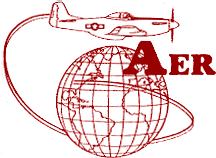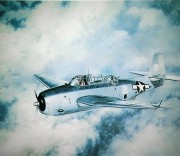|
Hymn to a Hummingbird
Or What It's Like To Fly A Helicopter
by Jeff Pardo
I can still remember some of those crazy dreams: I'd be skimming treetops, passing songbirds and swallows; or sailing high over watery vistas, flying formation with sea gulls. But sometimes, my favorite times, I'd be just hovering, still as the proverbial hummingbird, arms fully extended, looking down at the amazed upturned faces, before furiously flapping my arms and flying away. What freedom! What joy! What a feeling of being alive! But only for one sweet moment. Because, with magical swiftness and a feeling of crushing disappointment, I'd wake up.
Dang! It was only a dream. Or was it?
Of course, as "grownups, " we do soar skyward on occasion, but most of us don't do it without screaming jet engines, a cacophonous headlong rush down several thousand feet of concrete, and the assistance of hurricane force winds rushing over gigantic aluminum wings. Some of us (according to the latest numbers from the Federal Aviation Administration, about one out of every 445 or so) even become pilots, mostly of the little gooney birds that can beat feet fast enough to start flying within the confines of two thousand feet of asphalt--and some within a scant few hundred feet of mowed grass!
I count myself among that lucky few. But there is an even more exclusive group, those that know the realization of what turns out to be that common childhood dream of flying with the grace and freedom of Tinkerbell: Helicopter pilots. (In the US, less than one out of every ten thousand people is a certificated helicopter pilot.)
Leonardo da Vinci conceived the idea well before it was a real engineering possibility....
Whether or not you are a pilot, you've probably wondered, too, what it would feel like to be held aloft without all the headlong hullabaloo and the need for a typhoon over your tail feathers, just as in your dreams. Perhaps it struck you as you zoomed upward in one of those indoor atrium hotel elevators, or maybe your fancy got tickled as you watched the Whirlybird settle in to land with a wounded soldier on the TV show M.A.S.H. To be able to take off and land wherever (almost) one wants, with little or no forward motion, was something I just had to experience.
Helicopters. The ultimate off-road vehicle, the el primo E-ticket ride. This side of an F-16, a Space Shuttle or a Harrier jet, a helicopter is the coolest thing on the base.
Leonardo da Vinci conceived the idea well before it was a real engineering possibility. And the first helicopter flight didn't happen until a good third of a century after the Wright Brothers first flew, but we've been at it ever since. Here's what this amazing machine can do: fly straight up, sideways, and backwards. You can do an adjutant's halt, spin around on your heels inside your own length, check your six o'clock, and pirouette back again. You can take off from a space not much bigger than you are. You can land in your own back yard. But here's something else. You can fly as high as your Skyhawk cousins, but you can also fly as low as you want. As long as you don't create a hazard to people on the ground, in helicopters, buzz jobs are legal. (That's not to say you don't have to be real careful, because one of the leading causes of accidents in helicopters is wire-strikes. Check FAR 91.119--aside from flying such that you wouldn't be creating an "undue hazard to persons or property on the surface" should your engine quit, you can ignore that "1000 feet higher than the highest obstacle within a radius of 2000 feet" that applies to fixed-wing aircraft, and also the one about being no closer than 500 feet from any person, vessel, vehicle, or structure in sparsely populated areas. What's more, the regulations exempt you from some of the visibility minimums required by airplanes (91.155 and 91.157). Why? Part of the reason is that the darn things are so maneuverable. They can get into and out of almost anywhere. It's no surprise that helicopters are the only form of conveyance created by man that has saved more lives than they've taken.)
[I]f learning to fly is like learning to ride a bike, learning to hover is like learning to ride a unicycle....
Yeah, helicopters are cool. And they really aren't that forbiddingly difficult to learn how to fly. After all, you learned to ride a bicycle, didn’t you? Dig back into your childhood memories for a second. Remember those training wheels? Remember the day you cast them aside and successfully tackled a two-wheeler? You may not have had the words to express it back then, but didn't it seem like a feat of near-impossible proportions to balance that bike on those thin rubber tires? Sure, forward motion confers some gyroscopic stability, but you knew even then that you were taking on a physical activity that involved making such small and rapid corrections that it seemed overwhelming! Corrections that have to be made so quickly that if you have to think about it, it's already too late! Helicopters aren't any different. But if learning to fly is like learning to ride a bike, learning to hover is like learning to ride a unicycle: it's one of the most challenging and transforming experiences you'll ever have. Luckily, though, once you burn it in, it's there forever. People don't usually ever forget how to ride a bike, and once you can hover, you can always hover.
But before we take our first ride--from a student pilot's perspective--let's check out the mount we'll be using: the ubiquitous Robinson R-22. Power is provided by the same engine that drives the propeller on most Skyhawks, a Lycoming 0-320, four-cylinder, air-cooled engine. It sits behind you, mounted upside down and backwards. It's de-rated from 160 hp down to 131 hp (for five minutes), and further down to 124 hp, max continuous. (So those horses aren't going to bust a gut, and that's one reason why engine failures in Robinsons are so very rare.) The two main rotor blades--and they're symmetric, by the way--are under-slung on a teetering hinge. They're about 25 feet across, and they spin counter-clockwise about nine times a second, as viewed from above. (French helicopter blades spin clockwise, wouldn't ya know.) If you're at the helm, you're in the right seat in a helicopter--not the left, as Captains are in airplanes. Inside, the controls, at first, will look somewhat familiar to a fixed-wing pilot: there is a "stick" and some "rudder" pedals and the usual complement of engine gauges and navigational instruments.
[T]he collective...[is] what really distinguishes the hummingbirds from the blue jays....
But there the similarity ends. You see, there's the matter of a little control for your left hand (from the right seat) that articulates much like an emergency parking brake in a car. It's the collective, and it's what really distinguishes the hummingbirds from the blue jays. It controls how much power you use, and you can see its effects on the manifold pressure gauge, which, along with all the other dials and gauges, sits in a tiny center console between the two seats. The collective changes the pitch of the main rotor blades throughout their span. At the end of the collective is the twist-grip throttle. Unlike a constant-speed propeller airplane, the throttle controls the rpm (not the manifold pressure, as in the airplane). I sure hope you don't ride a motorcycle, because the twist grip, aside from being on your left and not your right, is twisted in the opposite direction from that of your other "chopper" when you want to add power, making transitional learning all the more difficult.
And that funny bent stick I mentioned earlier? It's the cyclic, and it floats around between your legs, where it's connected to the rotor blades via linkages, tubes, bellcranks, and control horns. Movements of the cyclic translate into proportional increments of pitch in the rotor "disk" to achieve greater lift according to where you've moved your arm, right or left, forward or back. (And yes, there's a compensation for precessional forces, for those of you who might be wondering. The pitch horns are "hooked in" 90 degrees out of phase with their point of attachment.)
Remember those "rudder" pedals? Newton's law of action and reaction cannot be denied—the main rotors are a lot of mass to be tossing around. To contend with it, a small fixed-pitch prop, spinning about five times faster than the main rotor, hangs off the tail boom. Those pedals control the rpm of the tail rotor and, hence, the amount of countervailing force, as required. Put more simply, the tail rotor just blows air off to the left to keep the fuselage from rotating madly in opposite direction of the main rotor, which the engine is trying hard to whip around the other way! Being so far aft on the tail boom, the rotor gets the advantage of a long leverage arm, so it doesn't take very much force to do the job. Incidentally, the force required is much less when you're moving forward, due to the slipstream effect. In fact, your instructor will let you take the controls in cruise and you'll be able to fly straight and level, though you may not be able to do both at once.
[The instructor shows you] the Jesus bolt, the one which, upon its failure, will guarantee an introduction to The Man....
Okay, let's go fly! Your CFI has done the preflight, pointing out where the sprag clutch is, explaining that if the engine quits, you won't drop like a stone but instead will glide at about a 4:1 slope as the rotor goes from being a fan to a windmill. He's shown you all the couplings, bellcranks, jam nuts, safety wires, and telatemps (and oh yes, the Jesus bolt, the one which, upon its failure, will guarantee an introduction to The Man).
You're buckled in and watching as the mixture goes to full rich, master on, strobe on, and the engine comes to life. A flick of the clutch and alternator switches, and a couple of seconds later, the rotors begin turning as you don headsets. Oil pressure check, avionics on, and the hot mic switch on. Then you sit as the engine warms up. Magneto check, carburetor heat check, low rpm horn check, sprag clutch check, frictions off, governor on, and eyes outside. You follow along as the collective is slowly raised, and you feel that change in the vibrations that tells you you're getting light on the skids. You can feel the cyclic move slightly, and now . . . you rise, Magic-carpet like. He lets you try it, though you can see his hands right there, ready. He says, "Go ahead, let's move forward a bit. Take it slow." Suddenly, it dawns on you: you really don't have a free hand. Got an itch? Well don't let go of anything to scratch it! (Later, he tells you that you can knurl down the friction lock on the collective and let go of it a second or two. But make that scratch a quick one.) You move the cyclic forward and-- all hell breaks loose!
You're gyrating to and fro, yawing left and right, not holding hover height at all! You find out as your instructor assumes control that you really didn't need to move the cyclic, but give just inkling of pressure.... OK you try again. Just the slightest nudge.... That's better. Wait! Now we're sinking--and turning! You push on the pedals--but it gets worse! You find out that because you diverted some downward thrust sideways, you needed just a gentle squeeze more throttle (which you actually started to do, but too late), and also that you had to compensate for the now-increased torque with the tail rotor pedals. You want to go right, you push right--not left! A few more tries at this and you're starting to understand why it happens, but getting it to be instinctive will take time. (For those of you who fly airplanes, you already slew this baby dragon when you learned to taxi.) If the instructor handles the throttle, the collective, and the pedals, after a few minutes you find you can actually stay within an area the size of a basketball court for at least 10 seconds. Hey, progress!
You feel like the eye-stalk on some kind of crustacean....
Now he says, "Let's go buzz around the pattern." As you watch and follow along on the controls, he slowly edges the cyclic forward, with a little increase in collective, and you begin picking up speed. As you reach 15 knots or so, you feel a slight shudder, and he explains that you're going through "effective translational lift," (ETL) as the rotor becomes more efficient. You feel a slight twinge of vertigo as you start gaining altitude above 25 feet, then 50, then 100 as you climb out at 60 knots. (And he's adding LEFT pedal!) You feel like the eye-stalk on some kind of crustacean as you realize how totally panoramic the view is from in here. You can see everywhere but right behind you, with no obstruction except that tiny instrument console.
He lets you have the controls on downwind. You begin to notice that you're a good couple of hundred feet lower here than the usual airplane pattern altitude. For a fixed-wing driver, it feels a bit weird. You concentrate on maintaining altitude with the collective, but you see the airspeed dipping down to 50 mph, then 40...oh no! Wait a minute! This isn't an airplane; this is a hummingbird, remember? You're not going to stall! He lets you honk back a bit more until there you are, at 600 feet and a fixed point in space, not moving at all. You inch forward on the cyclic, as you pick up speed again, moving forward. Oops---lost a couple hundred feet there.... So you raise the collective a bit. Time to turn a left base, so you push lightly on the left pedal. You get admonished for making an "airplane turn." Nope, just lateral cyclic is what’s required to make the turn. He explains that at this speed, you only need a little more than half the power that you did in a hover. You watch as you close in on that tiny dolly over by the hangar, and you feel the sensation of returning to a more ground-bound perspective than from on high. And boy, that's a steep approach! No, again, he tells you. Perfectly normal: 10 degrees. A steep approach is more like 15 degrees. (And then if you have to get into a confined area, the last 50 feet or so can be 45 degrees or more.)
We’re only a few feet away from touchdown now. He controls closure with the cyclic, angle with the collective. You feel him add power as that ETL vibration comes back, and more as you enter a four-foot hover, and the carburetor heat comes off. He sidles over to the dolly, moving ever so smoothly, as if this delicate bird were a part of him; gently and precisely, he sets the skids down right in the middle of it. He slowly lowers the collective, neutralizes the cyclic & pedals, shuts the governor off, and throttles down to a cool-down rpm of about 70%. He says, "Well, how'd you like it?" You grin and give him a thumbs-up, and you see from his smile that he knows you know it was a silly question.
Well, I may not have learned much that first flight--I couldn't very well take notes, could I? Except that flying helicopters truly is the fulfillment of a dream. Tinkerbell and the hummingbirds don't have anything on me. Now I'm a confirmed rotorhead!
|


